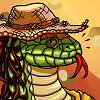Sign In
Close:D More world-building illustrations~
Island Spike Deer--Alongside a population of non-native white-tailed deer from the Brazilian mainland, island spike deer are small, stocky, and physically built more like mountain goats than graceful woodland creatures. They stand much shorter and can remain undetected in taller foliage even a few feet away, which helps the majority of them survive being stalked by the large predators on the island. Their horns typically have a single point each, with only very experienced and long-lived adults having a second prong growing in. They range from dark slate gray to pale tan to almost white in fur color. Mara Island is the only remaining stronghold for this species--it has been largely wiped out from surrounding islands by human incursion.
Goliath Rat Snake--One of the largest colubrid snakes in the world (possibly the largest) the Goliath rat snake can measure up to twelve feet in length and can be as thick as a human forearm. In the absence of any large arboreal boas or python species, this simple rat snake has evolved to be an expert hunter of bats, birds, and opossums. They can ascend completely vertical surfaces of an almost smooth texture--making gnarled jungle trees a breeze to slip up and down daily. They occupy a middle level of the island's food web, with their natural predators including Garuda and Maranaga and occasionally caiman and large fishes.
Mara Island Caiman--A large species of crocodilian, these caiman are somewhat unusual in that they spend much of their time outside the water, sunning in patches of light on the forest floor. They also exhibit more scavenger behavior than most crocodiles and alligators--often seen rooting for eggs in nests, carrion buried by other predators, and oddly enough taking advantage of fallen fruits. Despite this, they remain semi-aquatic and excellent hunters of fish, aquatic mammals, and water birds. Their only regular predator is Maranaga.
Black Heronlet--A rarely-seen nocturnal wetland-dweller, the black heronlet is a medium-sized bird that feeds on small fish, amphibians and reptiles. They are skittish and shy, having never been seen by humans until the late 50s--a full 180 years after the island's discovery. They tend to build their nests at the tops of huge trees, making fledging their hatchlings a challenge but keeping the eggs and newborns relatively safe from predation. Their calls are loud and obnoxious--but they never call when away from their nests or at night.
Rosy Jungle Grouse--These small chicken-like birds are numerous on Mara Island, almost to the point of being thick on the ground. They are prone to freezing when they feel they are being stalked--which often startles predators who stumble across them as they exhibit the same exploding sudden flight as many mainland species of grouse. In their mating season the males and females alike become brightly colored--the males turning the bright rosy-orange shown here and the females becoming an almost electric green-yellow.
Mara Opossum--This small marsupial is native only to Mara Island and occupies the tops of jungle foliage--it is much smaller than other native species of opossum but is a voracious carnivore. The Mara opossum eats mostly large insects but does not turn its nose up at small lizards, frogs, and mice. They can carry up to twelve tiny, squirmy kits in their pouch and still retain complete mastery of leaping, climbing, and scampering dexterity.
Short-tailed Nutria--A huge water-loving rodent, the major difference between this species and the usual nutria species is their long legs and very stubby tail, which makes them poorer swimmers but great at wading in shallower water to feed on vegetation. They make vocalizations much like guinea pigs of a deeper tone, and these sounds can be heard from over 200 yards away. Social and assertive, these semi-aquatic creatures live in large groups and tend to group up and fight back if they spot predators too close to their young or their feeding grounds.
Yellowbelly Iguana--Similar to the spiny iguana of Central America, the yellowbelly iguana is an herbivore that hangs out in the understory of forests on Mara and the surrounding islands. They frequently become prey for various carnivores on the islands, but have the advantage of speed from their smaller size but still retain their tail-whipping ability. Their clutches of eggs can produce over forty tiny lizards at once, which are bright yellow all over and are often mistaken for anoles.
More interesting creatures that Maranaga share the island with coming soon~ Or later, whenever they're done~ XD
P.S.--That caiman is super-cuteness. XD Along with the others...
Submission Information
- Views:
- 1027
- Comments:
- 0
- Favorites:
- 0
- Rating:
- General
- Category:
- Visual / Digital




